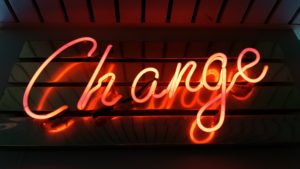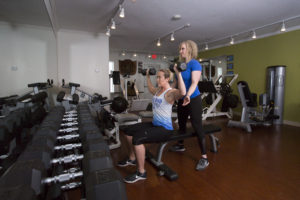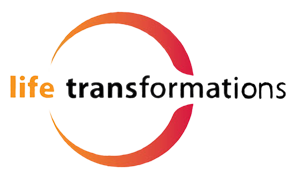Life Transformations Personal Training in Lee’s Summit shares tips on health and fitness. Now is the time to inspire change in your life. New Years can call for a time to make changes, it doesn’t have to be a New Year’s Resolution, it can be a change. To make a change successful, you must make sure it can successfully fit into your daily life. Let’s get to change Lee’s Summit!
Below are some ideas for things to change:
Start a fitness program. Adding exercise into your day can have many benefits. It is important to be realistic in making a program. You want to be able to follow what you set out to do. Think of where you will workout and how long. You can always add as more time is made available.
ACSM (American College of Sports Medicine) recommends the following:
Do moderately intense cardio 30 minutes a day, 5 days a week
OR
Do vigorously intense cardio 20 minutes a day, 3 days a week
AND
Do 8-10 strength- training exercises 8-12 reps of each exercise twice a week
*Moderate-intensity physical activity meals working hard enough to raise the heart rate and to break a sweat, yet still being able to carry on a conversation.
*Recommendation is for the average healthy adult to maintain health and reduce risk for chronic disease. 60-90 minutes of physical activity may be necessary to maintain weight loss.
Cardiovascular training is vigorous activity that increases heart rate and respiration. Examples are walking/running, biking, mowing lawn at quick pace, treadmill, Elliptical.
walking/running, biking, mowing lawn at quick pace, treadmill, Elliptical.
Resistance training is using resistance to build strength. The more you use resistance, the stronger you become. Examples of resistance forms are body weight (pushups), bands (banded chest press), weights (bench press or dumbbell press).
No matter how slow you are going, you are still lapping everyone on the couch- Unknown
Limit Refined Sugar Refined sugar is sugar naturally found in foods like corn, sugar beets, and sugar cane. These are empty calories that have no nutritional value. The American Heart Association claims that “the average American consumes approximately 22.2 tsp of added sugar per day, which equates to 355 calories! They suggest aiming for only six tsp. or 100 calories per day, for most women and no more than nine tsp., or 150 calories of added sugar a day, for most men.”
Here are some tips to avoid refined sugar.
- Cut back on sugar filled drinks (soda, juice, energy drinks)
- Avoid desserts loaded with sugar
- Eat whole foods and limit processed foods
- Limit sugary breakfast cereal and foods
Portion Control -You can know the portion size by reading the food label. But what if you are at a restaurant or cooking dinner. How much food should be on your plate? You can always measure, but you may not always have a measuring cup on you. But there is an easier way. Look at your fist. Your fist should be about 1 serving. This can go for proteins, carbs, vegetables, etc. An example dinner would be a fist of chicken, fist of rice, fist of vegetables. You always have your fist with you, use it to help with portions.
An example is rice. A serving of rice is ½ cup. Think of going to a restaurant, how many servings did they serv? Use your fist to estimate 1 serving. Then take the rest home.
Follow a healthy eating plan– Eating healthy can be easy, it can take time, it can be cheaper than eating out, it can be hard to avoid processed foods. There are many factors that come into play with eating healthy. Time, taste, family, and more. It is best to stay within your limits. This way you will make the most success. Start with introducing healthy eating habits into your week. Since you know how to read Food Labels, you can know what is in the foods you are eating. Now you need to choose healthy foods to eat. A trip to the store is in tow. But first plan out some meals and snacks for the week. Thinking of eating healthy as a lifestyle change works best. It is not a diet; it is something you can do for an extended period.
A good resource for healthy eating is www.Myplate.gov. There are many resources on healthy foods, recipes, tips for families, and more. Below is a healthy food list for ideas.
Here are links to some of my favorite healthy recipes
Lunch/Snack Ideas Dinner Recipes Easy Chicken Recipes Summer Recipes
Increase Water– Hydration is crucial for many reasons. It helps to regulate body temperature, lubricate joints, prevent infections, and keep organs functioning properly. Being hydrated also improves sleep, cognition, and mood.
Tips for hydration
To stay hydrated, don’t just think: I have to gulp water all day long. The best way to stay hydrated is to drink water, but it does not have to be boring. Here are some tips for hydration.
but it does not have to be boring. Here are some tips for hydration.
- Start early in the day. It is easier to drink water in the AM. Start your day with a bulk of your daily recommended intake. Then you will feel hydrated during the day. Also, prevent trips to the restroom in the middle of the night.
- Drink when eating. Try to drink water each time you eat. This will not only help with water intake, but aid in digestion.
- Add to your water. If you are not the type of person that likes to drink water, you can add to it to make it more enjoyable. Adding citrus fruit (lemon, lime, orange slices) will add a subtle taste to the water. If needed, water enhancers can add flavor. Make sure to watch quantities, many have artificial sweeteners (many opinions on these, but use in moderation)
- Caffeine is a mild diuretic or de-hydrant (make kidneys release more urine, so effects hydration status). Be aware of coffee, tea, soda intake. Limiting caffeine will help you stay hydrated during the day.
- Keep water with you during the day. Have a water bottle or cup of water with you at work, in the car, or while at home. Having it close by will encourage drinking more.
- Choose your water temperature. Some people like ice cold water, others like room temperature. Typically, you can drink room temperature water quicker, especially in the cold months.
Practice Relaxation- Take some time each day to practice relaxation techniques, then it will become more of a routine. Below are some easy relaxation drills.
Guided imagery is taking a short vacation in your mind. You can involve imaging being in your happy place. This is different for everyone. It may be the beach, on a mountain, in your room, etc. What do you hear, see, smell, feel?
is different for everyone. It may be the beach, on a mountain, in your room, etc. What do you hear, see, smell, feel?
Muscle Relaxation involves relaxing all your muscles. Think of your body in sections (upper, lower, limbs), then relax each section. Take a few deep breaths, tighten and relax each muscle. You should be able to feel your muscle tension relaxing away.
Meditation brings stress relief and stress management benefits. This involves focusing on your breathing. Changing the way you breathe can make a big difference to your overall stress level. Taking deep breathes, focusing on YOU, and clearing your mind can help calm your body.
Try this. Breathe in through your nose, fill yourself with air, count to 3 as you inhale, hold your breathe for a second, then slowly let your breathe out through your nose as you count to 3.
Now, if you want to fully relax and reduce stress, try the above three relaxation techniques together.
Do your meditation breathing, while visualizing your guided imagery, and relaxing your muscles. There is a lot to focus on and it can take time to master but think of how relaxed you will be.
*Link for positive affirmations
You can implement change through a process. Follow the steps for a more successful change process.
Think of change
Think about what you want to change and why you want to make the change.
Your answer may be set a good example for my kids, prevent disease, health improvement, feel better about myself, need a change to better a relationship, be happier, doctor recommended a change. Make sure to journal your answer, this is your WHY. If you are unsure of your WHY, take a little bit to think about it. Reflect back on your WHY when you are struggling with making your change.
Vision Statement
Now we are ready to make a plan to change. What is going to be required for this behavior change? How will you overcome obstacles? Let’s make a plan to answer these questions. Another way to think of this plan is a vision statement. This is a plan from YOUR perspective as to how you are going to make the behavior change. Think of it as a picture of how you want to be in this area of your life. Think about Why you want to make this change, what will this mean to you, how will you make this change happen?
Action Steps
Now we need a plan to get the vision statement to come to life. Plan some action steps. This is HOW YOU are going to put the vision into reality. Record your thoughts.
Challenges
Do you have challenges to overcome to make a change? Have you overcome these challenges in the past? You may face challenges in implementing your wellness vision. But, knowing your challenges and being ready for them will help your overcome them. Make some notes in your journal on challenges to your vision.
Challenges
Do you have challenges to overcome to make a change? Have you overcome these challenges in the past? You may face challenges in implementing your wellness vision. But, knowing your challenges and being ready for them will help your overcome them. Make some notes in your journal on challenges to your vision.
Support
It works well to have a support system in place. Do you have a friend, family member, or significant other to support you in your wellness vision? Share your vision with them and lean on them as needed. Call, message, or share thoughts with them. Reach out to your support system as needed.
Evaluate Success
Think back on what you have changed. How have you been successful? What have you overcome? Success is achieving something you have been trying to do. Your wellness vision statement. How successful have you been? What are your achievements? Jot down some notes in your journal on your success.
Wellness can be useful in nearly every human endeavor; it is applied to all aspects of your life. It encompasses mind, body, and spirit to make up your well-being. Living a healthy lifestyle is having an overall positive well-being. You are starting a new journey, you have not just made a choice to be healthy, but you have decided to make a change. Change can be hard. Not just initiating but maintaining a change into a habit. You can feel good and be well. Making the choice to make a lifestyle change is your way of moving toward optimal health. I hope this new journey becomes a way of life.
Wellness is a choice, a way of life, a process, an efficient channeling of energy, an integration of the mind, body, spirit and a loving acceptance of self. -John Travis
The main thing to remember when making a change in yourself, something is better than nothing. Don’t be hard on yourself if you don’t achieve goals in one day. Little steps make you closer to your goals. If you stumble or take a little detour on your path to change, it is important to get back on track. Look at why you started.
Happy Change & Health Improvement
Molly Wichman
Life Transformations Personal Training
Wellness Coaching
Photo credits by Anderson Rian on Unsplash
Photo by Ross Findon on Unsplash
